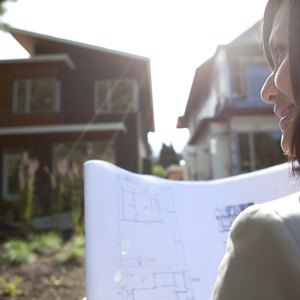
A walkthrough from a licensed appraiser is an inevitable part of selling or refinancing a home. Whenever there's a mortgage involved, the lender will require a professional opinion of the home's value to ensure it is not priced above what it is worth. The appraiser is an independent expert who bases his opinion purely on the market and the state of the property. Within these two broad categories, the appraiser looks at a number of factors to get an accurate valuation.
Tips
Broadly, a home appraisal consists of two things: an examination of the "comps," or the selling prices of similar homes in the neighborhood, and a walkthrough to inspect the physical condition of the property.
The Process Starts With Market Data
Imagine you wanted to buy a tablet from eBay. Before submitting a bid, the chances are you'd take a look at the kind of prices that tablets of your preferred make and model were going for. Comparison shopping helps you set a baseline price for the product so you can be sure you're not paying more than the going rate.
Home appraisals work exactly the same way. Before setting foot in the home he's appraising, an appraiser will take a look at the typical selling prices in your area. He does this by gathering comparable market data, or "comps," for similar homes that have sold in your neighborhood over the last few months. The older the data, the less accurate it is in describing the current state of the real estate market, so ideally the comps should be no more than three months old.
Here's an example. Suppose that you're selling a three-bedroom, 2,000-square-foot townhouse. Four, three-bedroom townhouses with a similar square footage have sold in the last three months, with prices of $200,000, $220,000, $190,000 and $245,000 respectively. The average selling price is $213,750. The appraiser will use the average price, which is often expressed as a price per square foot, as a baseline valuation when appraising the subject property.
What Happens During a Walkthrough?
After performing a comparable sales analysis, the appraiser will walk through the house and make a note of the features and amenities that potentially could impact its value. Most appraisers use a document known as the Uniform Residential Appraisal Report when conducting their walkthrough, which essentially is a checklist of the factors that influence the value of a home. Briefly, the key points are:
The home's size and square footage. The appraiser will apply the price per square foot from his comps to get a starting valuation for this property, so the home's size is a large portion of what goes into the appraised value of a home.
The number of bedrooms and bathrooms. The more bedrooms and bathrooms you have, the more you can expect the house to be worth.
Site conditions. Encroachments from a neighboring building, rights of way over the yard or lots of foreclosures in the neighborhood can all have a downward effect on the home's value.
Defects in the construction. Defects reduce the appraisal value, especially if the foundation, walls or roof are in disrepair or the home violates building codes.
Condition of the interior. While the appraiser is not interested in your curtains and color scheme, things like doors, windows, flooring, electrical installations, plumbing and the condition of the kitchen can impact the home's value.
Extras and additions. The appraiser will pay close attention to any upgrades or renovations you've made and the quality of those improvements. Replacing old and inefficient appliances with energy-efficient upgrades could reduce energy bills and add years to the lifespan of your kitchen, all of which has an impact on the home's value.
Give a Little, Take a Little
The next part of the home inspection takes place behind the scenes. Starting with the baseline value from the comps, the appraiser will add value or deduct value based on whether the property is better or worse than the other homes in the neighborhood.
For example, if the home being appraised has a new kitchen, new siding, new fencing and a landscaped garden, the appraiser might decide that home is worth $235,000, or around $20,000 more than the average selling price for the area. If the house is painted hot pink on the outside, has broken windows and is sandwiched between two foreclosures, the appraiser may decide that the home is worth $190,000, or around $23,000 less than the average selling price for the area.
As to how much is added or deducted, it's not an exact science. A bank could hire three different appraisers to value your home and get three different figures. Ultimately, you have to trust the appraiser's professional expertise. Appraisers have a sharp eye and are trained to spot the type of defect (like power lines running by your lot) or additions (like a new bath) that take your property outside the norm for your neighborhood. Anything outside the norm warrants some type of movement on price.
Is an Appraisal the Same as a Home Inspection?
An appraisal is not the same as a home inspection. A home inspection is intended to identify repair issues with the property – problems the seller can fix or give a discount for before money changes hands. An appraisal, by contrast, aims to determine the value of the home in the current market.
So, whereas a home inspector is looking for electrical problems, broken roof tiles, dampness and mold infestations, an appraiser is chiefly concerned with comparing the features of your property to other similar properties in the neighborhood. He doesn't care about repair items unless they impact the value of the home.
For Federal Housing Administration and Veterans' Affairs-backed mortgages, the lines may blur a little. Here, the appraiser must look for certain deficiencies such as missing handrails, fallen-down fencing, peeling paint on exterior surfaces and detached guttering. Nonetheless, the appraiser must still form an opinion on the value of the property and it's still the comps that will weigh the heaviest on his opinion of value.
Real Estate Appraisal Myths
Over the years, a number of myths have built up regarding the real estate appraisal process that need to be dispelled:
A low appraisal will kill the home sale. If the property is appraised lower than the offer price, the deal can still go ahead. It just means the bank will not lend more money than the house appraises for. The buyer could make up the difference or the seller could drop the price a bit to save the deal.
Upgrades will improve the appraised value. Sadly, there are some renovations that actually decrease the home's value, and many more than will not get full return on the investment that's been made. Just because a homeowner spends $60,000 on a high-end kitchen does not mean the appraisal value will go up by $60,000.
As we have seen, by far the biggest factor in a home's appraisal is the selling price of other homes in the neighborhood. Homes are appraised based on their area, not their granite counter tops. If the neighborhood is full of lower-priced homes, then this house will be lower-priced too, even if the owner has spent a fortune on makeovers. As a general rule, most houses will appraise within 20 percent of the comps for their neighborhood and nothing more.
The appraiser serves the needs of the buyer. The buyer may be paying for the appraiser but ultimately, the appraiser works for the lender. He's there to make sure the bank is not lending more money than the property is worth. Neither the seller nor the buyer has any say in the appraisal, and there are laws in place to remove any bias or coercion from the process.
References
- Fannie Mae: Uniform Residential Appraisal Report
- AI Home
- Fit Small Business: What Is a Home Appraisal & Who Pays for It?
- Fannie Mae. "Appraisal Waivers Fact Sheet," Accessed Nov. 4, 2019.
- American Family Insurance. "Home Inspection and Appraisal Process," Accessed Nov. 4, 2019.
- Rocket Mortgage. "The Home Appraisal: What Sellers and Buyers Should Know," Accessed Nov. 4, 2019.
Writer Bio
Jayne Thompson earned an LLB in Law and Business Administration from the University of Birmingham and an LLM in International Law from the University of East London. She practiced in various “big law” firms before launching a career as a commercial writer specializing in finance and tech. Her work has appeared on numerous financial blogs including Wealth Soup and Synchrony. Find her at www.whiterosecopywriting.com.

